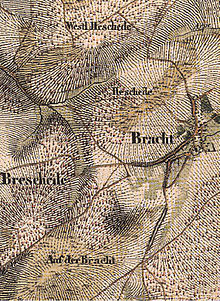Bracht (toponym)

Bracht is a toponym that occurs in settlement and field names . The settlement names are more common in the western Sauerland and Bergisches Land , but occur in the west as far as Flanders . The much more common field names extend well beyond this core distribution area.
etymology
The exact origin and meaning of the word Bracht ( feminine ) are unclear. It probably goes back to a Germanic word * brahti- or * brahtjō, the meaning of which cannot be explained with certainty. The word is only known in place names and is missing in today's dialects or older language levels.
The Old High German / Old Saxon braht ( masculine ; noise, shouting), New High German splendor (noise, shouting, pomp) is not accepted as the basis for the designation. Other attempts at explanation are undergrowth, thicket (to Brake), fallow land, dormant field or a borrowing from the Latin fracta (fragment), which is supposed to have the connotation mountain . The declaration of clearing marked areas contradicts the fact that many Bracht areas were not suitable for the construction of settlements. Because of the exposed location of the brought, they were interpreted as an observation station to secure the Frankish rule; So far this is based on the investigation of the brought in Hesse and can therefore only partially serve as an explanation for the much larger distribution area without more extensive investigations.
The basic word Bracht or umgelautet Brecht (e) is often weakened in settlement and field names, usually to -bert or -pert, with a preceding nasal to -mert or -mart. Because of possible reinterpretations that can be proven in settlement names, for example Gummersbach from Gumeresbracht, it is unlikely that all Bracht place names can be identified. Since old evidence for field names is mostly missing, such reinterpretations can hardly be proven, but it cannot be assumed that they only occurred in the case of settlement names. Conversely, it cannot be ruled out that, for example, -mer to -mert has been expanded and thus appears like a Bracht name.
Settlement names
Bracht has been used to name settlements since the 9th century at the latest. Examples are Velbert (875: Feldbrahti ), Gummersbach (1109: Gummeresbracht ) or Plettenberg (around 1070: Plettonbrath , 1187: de Plettenbraht ). As determiners come - as opposed to field names - names of persons as in Meinkenbracht ago.
The core of the distribution area is the region between the Ruhr and Sieg , in the west it extends to the Rhineland , the Eifel , the Ardennes and Flanders . North of the Ruhr, only the Bracht farmers south of Sendenhorst can be identified in Westphalia . These settlements are mainly characterized by elevations or hills.
Field names
The distribution area of the field names extends beyond that of the settlement names, but also has its core in the Sauerland and Bergisches Land. In Hesse, where there are only a few Bracht settlement names, field names are particularly well represented in the northwest.
Bracht field names mostly refer to larger areas. In South Westphalia, the Bergisches Land, the Rhineland and Hesse, forests and altitude are typical. In the Münsterland and the eastern Netherlands, altitude does not always apply, but original forest stands are possible.
Bracht occurs in the entire range as a simplex . A widespread extension is Hohe Bracht or Homert , which can have originated from (on) Hohe Bracht . In the case of many compound nouns , the defining word cannot be interpreted. With names ending in -mert, it is not always certain whether they go back to the basic word Bracht.
Bracht is rarely used as a defining word, but it does occur, for example in the name of Brachtpe .
literature
- Gunter Müller: Westfälischer Flurnamenatlas (4th delivery). Publishing house for regional history, Bielefeld, 2006, ISBN 3-89534-604-7 , pp. 407-410.
- Hans Ramge: The Hessen Bracht and the Franconian state development. In: R. Bergmann, H. Tiefenbach, L. Voetz (Eds.): Old High German. Volume II, Heidelberg 1987, pp. 1401-1432.
Individual evidence
- ↑ Excerpt from the certificate from 1109. The sign above the u stands for a following m.
- ^ Klaus Pampus: First documentary mentions of Oberbergischer places. ISBN 3-88265-206-3